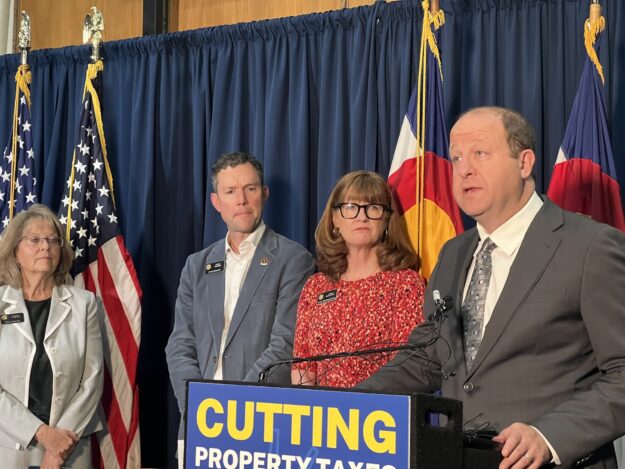Widgetized Section
Go to Admin » Appearance » Widgets » and move Gabfire Widget: Social into that MastheadOverlay zone
Draconian ballot measures withdrawn as Gov. Polis signs property tax cuts into Colorado law

Colorado Gov. Jared Polis speaks at a property tax bill signing at the Colorado Capitol on Sept. 4 (Sara Wilson/Colorado Newsline).
Gov. Jared Polis signed a bipartisan package of property tax cuts into law on Wednesday, after supporters of a pair of ballot initiatives that proposed deeper cuts withdrew them earlier in the day.
House Bill 24B-1001 is the result of a four-day special legislative session that ended last week. In exchange for that bill’s passage, two conservative groups agreed to remove Initiatives 108 and 50 from the ballot. The measures would have slashed residential and commercial property assessment rates and limited future revenue increases with a 4% annual growth cap.
“This is really an example of bringing folks together, who may not see eye to eye on every issue, on a path forward that’s better for Colorado, taxpayers, schools, fire districts — and better for everyone than taking great risks,” Polis said ahead of signing the bill.
Backers of the ballot initiatives withdrew them on Wednesday morning, according to the secretary of state’s office. The two conservative groups behind them, Advance Colorado and Colorado Concern, have committed to not running property tax initiatives for at least six years.
The special session bill was sponsored by House Speaker Julie McCluskie, a Dillon Democrat; Minority Leader Rose Pugliese, a Colorado Springs Republican; Sen. Chris Hansen, a Denver Democrat; and Sen. Barbara Kirkmeyer, a Weld County Republican. It passed both chambers with bipartisan support.
It will cut property taxes by about $255 million in the 2026 tax year and save the average homeowner less than $100 in the 2025 tax year by building upon a $1.3 billion property tax cut that the Legislature passed in May. It trims residential assessment rates, includes more business property types in the commercial rate cut from earlier this year and sets a 5.25% growth cap on the property tax revenue collected by local governments and school districts.
In comparison, the ballot initiatives would have resulted in a $2.4 billion cut.
“It is unfortunate that we had to play defense, that we had to come forward and provide that additional relief because wealthy interests in this state continued to bring forward ballot measures that would ultimately undermine the stability of our communities,” McCluskie said.
Some lawmakers pushed back on the reason for the special session, claiming that Polis and others bowed to the groups that placed the initiatives on the ballot and used them as a high-risk bargaining chip to get further property tax cuts. They also criticized the bill’s process, which was negotiated behind closed doors and presented to lawmakers shortly before the special session started.
But Polis and sponsors defended the legislative process, saying the bill was properly developed with stakeholders and shared with the Legislature and the public on a typical timeline.
Polis and legislators hope this will button up years-long instability around the state’s property taxes following the repeal of the Gallagher Amendment in 2020. That constitutional amendment set a ratio on how much property tax revenue could come from homes versus businesses.
“Since 2020 and the repeal of the Gallagher Amendment, unpredictability has burdened our state’s property tax system,” Kirkmeyer said. “It’s created frustration for homeowners, small businesses and local governments alike. The people of Colorado deserve certainty.”
Editor’s note: This story first appeared on Colorado Newsline, which is part of States Newsroom, a nonprofit news network supported by grants and a coalition of donors as a 501c(3) public charity. Colorado Newsline maintains editorial independence. Contact Editor Quentin Young for questions: info@coloradonewsline.com. Follow Colorado Newsline on Facebook and X.


